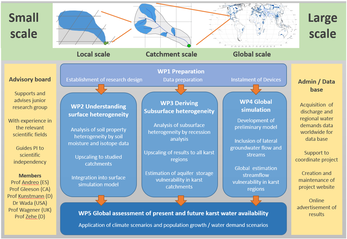Global Assessment of Water Stress in Karst Regions in a changing world
Aims and objectives
The aim of the project is to improve the general understanding of karst processes to quantify present and future karst water stress at a global scale, hereby supporting decision making that can mitigate the consequences of water stress on socioeconomic systems. The project will apply novel monitoring, analysis and large-scale modelling schemes to advance in
The aim of the project is to improve the general understanding of karst processes to quantify present and future karst water stress at a global scale, hereby supporting decision making that can mitigate the consequences of water stress on socioeconomic systems. The project will apply novel monitoring, analysis and large-scale modelling schemes to advance in
- understanding and including karstic heterogeneity in hydrological models,
- upscaling catchment based observations and simulation approaches to the global scale, and
- comparing present and future water resources availability with water demand across the globe.
|
Project design
To process these research objectives, five work packages (WPs) are defined, which are accompanied by a project administration and an advisory board. To ensure progress in all work packages and high scientific quality an advisory board support the group's decisions. It is composed of an international team of experts with complementary experience. It will also guide the PI of the group to become an independent researcher and successful project manager. Furthermore, administrational support, KDB maintenance and data acquisition, as well as the maintenance of a project webpage are included in the project. |
Flow chart of research concept of the GloW project (blue areas in the maps indicate carbonate rock areas)
|
|
WP1 COMPLETED
represents the initiation period of the project, during which the sensors for WP2 will be installed, and the data and research design for WP3 and WP4 will be prepared. WP2 will deal with the understanding of karst recharge processes at the surface. Using a dense network of soil moisture monitoring stations and frequent sampling of soil water stable isotopic composition at 5 karst experimental laboratories (KELs) in different climate regions around the globe the heterogeneity of karst recharge processes will be quantified, and incorporated into catchment scale groundwater recharge models. WP3 will use the global data base of karst system discharge time series to infer about the heterogeneity of aquifer storage and discharge behaviour (hydraulic conductivities and storage volumes) and will develop methods to upscale that information to other ungauged karst regions. |
WP4
will use the available information from the KDB and other public databases, and the knowledge obtained in WP2 and WP3, to develop a global hydrologic karst model. The model will be set up and evaluated by a stepwise procedure looking at small karst systems first before including larger karst systems with regional groundwater flow processes and lateral drainage into streams. Evaluation will include tests of performance, sensitivity analysis and plausibility analysis using the information gained in WP2 and WP3 to achieve an optimal use of all available information to model global karst water resources. Also the model will be compared to commonly-used large-scale models that do not include karst processes. WP5 will finally combine all knowledge gained in WP1-4 to analyse global present and future karst water stress. The global simulation model will be coupled with climate projections and present and future water demand of karst regions will be assessed by projections of population growth and per capita water demand. |
Research project funded by the German Research Foundation

